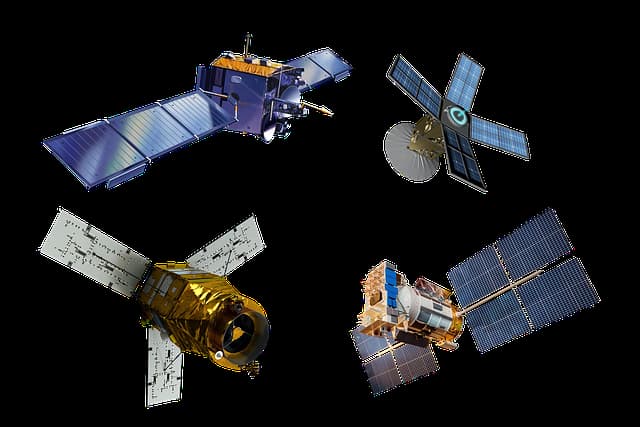The satellite system (SS) is used to organize high-speed microwave long lines, which require direct visibility of the transmitter and receiver, because the Earth’s surface has curvature, so direct visibility is impossible. The solution to this problem was the invention of artificial satellites, which are reflectors of electromagnetic signal.
In today’s world, a satellite can play the role of a primary network node, a telephone switch and a router-switch of a computer network, which is achieved by the interaction of satellite hardware not only with ground base stations, but also among themselves, forming direct space networks.
Modern satellites have four types of orbits, in which they move:
Geostationary satellite. The satellite rotates over the equator at the speed of the earth.
- The satellite, due to its high orbit, covers a quarter of the Earth’s surface.
- Satellite is stationary for ground antennas, which greatly facilitates the organization of communication, so there is no need to automatically correct the direction of the ground antenna, as we have to do for low-orbit and medium-altitude satellites.
- Satellite is at a considerable height from the Earth’s atmosphere, the less wear and tear, which increases its service life. Low-orbit satellites, because of friction against the air, constantly lose altitude and have to regain it with engines.
- Satellites have a large number of antennas, which allows them to maintain a large number of communication channels.
To receive a signal from such a satellite, it is necessary to use parabolic antennas up to 10 m in diameter, but with the advent of directional antennas, which were installed on satellites,
the diameter of the receiving antenna was reduced to 1 m.
A disadvantage of satellites in geostationary orbits is that they are located at a great distance from the Earth’s surface, which leads to large delays (from 230 to 280 msec) in the transmission of signals. In addition, at such distances are very high signal losses.
Medium-orbit satellites.
These satellites cover 10,000 to 15,000 km of the Earth’s surface and have a delay in signal propagation.
terrestrial territory and provide signal propagation delay of about 50 msec. The most known systems using such satellites are GPS and GLONASS systems.
GPS satellites are located in six planes at an altitude of approximately 20 180 km from the surface of the planet. GLONASS satellites are located in three planes at an altitude of about 19,100 km altitude. The nominal number of satellites in both systems is 24.
Both systems use signals on the basis of pseudo-noise sequences which gives them high noise immunity and reliability at low transmitter power.
According to the purpose, each system has two base frequencies – L1 (standard accuracy) and L2 (high accuracy). GLONASS uses frequency separation of signals, that is, each satellite operates on its own frequency. Each satellite of the system besides basic information transmits also auxiliary information necessary for continuous operation of receiving equipment.
Low Earth orbit satellites.
The main advantage of such satellites – the proximity to Earth, and therefore lower power transmitters, small size of antennas and short signal propagation time (about 20-25 msec). The main disadvantage of these satellites is that They have a very small coverage area – only 8000 km. Revolutions period of such a satellite around the Earth Earth revolution period of such satellite = 1,5 – 2 hours. Time of communication with a base station is approximately 20 minutes. In addition, because of the low orbit, such satellites are very strongly affected by the atmosphere, which limits service life of such satellites 8-10 years. “Iridium and Globalstar are the main companies using low-orbit satellite systems for mobile communications in places where installing cellular base stations is not possible or very difficult.
Now in the Iridium system (Iridium) operates 66 low-orbit satellites, placed on the 6 circumpolar orbits. The mechanism of inter-satellite communications allows to transmit a signal from one satellite to another without retransmitting this signal to the Earth. The bandwidth in each direction is 25 Mbit/s. The Iridium satellites are located 780 km above the Earth’s surface, below all other satellites used by other known mobile satellite communications systems.
The space segment of the Globalstar system includes 48 primary and 4 reserve satellites, weighing about 450 kg each, located in circular orbits in 8 planes at an altitude of 1414 km, 6 satellites in each. “Globalstar” orbits have an inclination of 52 degrees. Thus, Globalstar does not extend to the polar regions. Globalstar satellites have two body-mounted antennas turned toward Earth.
Satellites of highly elliptical orbits.
Elongated elliptical orbits with a perigee radius of about a thousand kilometers and an apogee radius of one or several tens of thousands of kilometers.
If a satellite’s orbit is highly elliptical, it will spend most of its orbital period around the Earth in an area close to apogee where it moves very slowly. This means that the satellite can be within sight of ground stations for most of orbit period, then it disappears from visibility. By placing several satellites in the same elliptical orbit at equal distances from each other, a continuous service effect can be achieved.
Using a High Elliptical Orbit can provide signal coverage anywhere on the globe. The movement of HEO orbits is not limited to equatorial lines, the use of which leads to insufficient coverage of high and polar latitudes.
The main disadvantage of the elliptical orbit is that the position of a satellite in this orbit relative to the ground station position of the satellite relative to the ground station is constantly changing.
Since communications satellites are mostly located near the equator, the lack of communications in the high-latitude Arctic remains a serious problem that needs to be addressed as commercial, scientific, and tourist activities move farther out.









